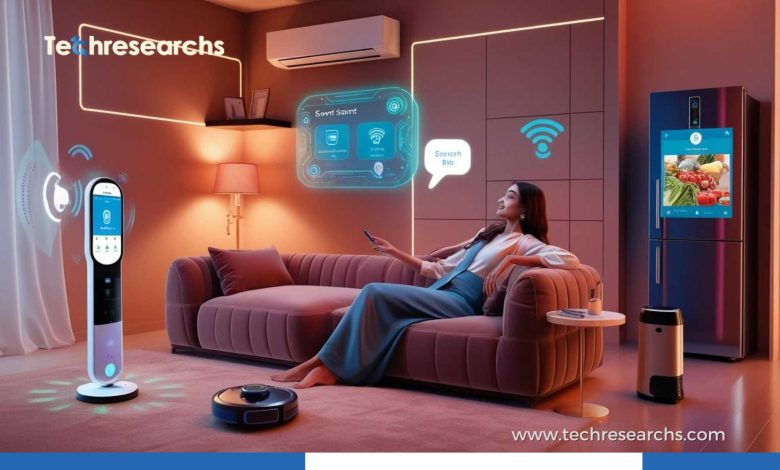How IoT Smart Home Devices Can Make Your Life Easier

In today’s fast-paced world, IoT smart home devices are transforming the way we live. From voice-controlled assistants to automated security systems, these innovative technologies make homes more efficient, secure, and convenient. But how exactly do they enhance our daily lives? Let’s explore the benefits and functionality of smart home devices in detail.
What Are IoT Smart Home Devices?
IoT smart home devices are internet-connected gadgets that enable automation, control, and monitoring of home functions. These devices use wireless networks to communicate with each other and can be operated remotely via smartphones, voice assistants, or centralized hubs.
Examples of Popular IoT Smart Home Devices:
| Device Type | Example Devices | Primary Benefit |
|---|---|---|
| Smart Assistants | Amazon Alexa, Google Assistant | Hands-free control |
| Smart Lighting | Philips Hue, LIFX | Energy efficiency |
| Smart Security | Ring Doorbell, Nest Cam | Home safety |
| Smart Thermostats | Ecobee, Nest Thermostat | Temperature control |
| Smart Appliances | Smart refrigerators, ovens | Convenience & automation |
Benefits of IoT Smart Home Devices
1. Enhanced Convenience and Control
With IoT smart home devices, you can automate everyday tasks like adjusting the thermostat, turning on lights, or setting reminders. Voice assistants like Alexa or Google Assistant allow you to control multiple devices effortlessly.
2. Increased Home Security
Smart locks, surveillance cameras, and motion sensors provide real-time security monitoring. These devices send instant alerts to your phone, ensuring better home protection whether you’re at home or away.
3. Energy Efficiency and Cost Savings
Smart thermostats and lighting systems optimize energy consumption, reducing electricity bills. Many IoT smart home devices also analyze usage patterns and suggest ways to save energy.
4. Improved Comfort and Customization
Personalized settings on smart devices allow users to create custom automation routines. For example, you can program lights to dim at night or set air conditioning to turn on before you arrive home.
5. Remote Monitoring and Accessibility
IoT technology allows homeowners to monitor their devices remotely through mobile apps. This means you can lock doors, check cameras, or adjust settings from anywhere in the world.
Challenges of IoT Smart Home Devices
Despite their advantages, IoT smart home devices also come with challenges:
- Privacy and Security Risks: Unauthorized access can lead to data breaches.
- Connectivity Issues: Poor Wi-Fi signals can disrupt device functionality.
- High Initial Costs: Some smart home systems require significant investment.
Solutions:
- Use strong passwords and two-factor authentication.
- Invest in reliable internet connections for seamless connectivity.
- Choose budget-friendly smart devices with essential features.
How to Choose the Best IoT Smart Home Devices
1. Identify Your Needs
Are you looking for security, energy efficiency, or convenience? Choose devices based on your specific requirements.
2. Check Compatibility
Ensure that new IoT smart home devices integrate with existing systems like Alexa, Google Home, or Apple HomeKit.
3. Look for Security Features
Opt for devices with end-to-end encryption, secure logins, and regular firmware updates to protect against cyber threats.
Future Trends in IoT Smart Home Devices
The future of IoT smart home devices looks promising, with advancements such as:
- AI-powered automation for more intuitive smart homes.
- 5G connectivity for faster and more reliable operations.
- Integration with renewable energy sources for sustainability.
Frequently Asked Questions (FAQs)
1. Are IoT smart home devices safe?
Yes, but users should take precautions like using strong passwords, enabling two-factor authentication, and keeping software updated.
2. Do IoT smart home devices save money?
Yes, smart thermostats and lighting systems help reduce electricity consumption, lowering utility bills over time.
3. Can IoT devices work without the internet?
Some smart home devices have offline modes, but most require internet connectivity for full functionality.
4. What are the most essential IoT smart home devices?
Popular choices include smart assistants, security cameras, thermostats, and lighting systems.
IoT smart home devices offer a smarter, more efficient, and secure way to manage daily tasks. Whether it’s energy savings, convenience, or security, these devices continue to revolutionize modern living. By choosing the right smart home solutions, you can enhance comfort and improve overall home management.



